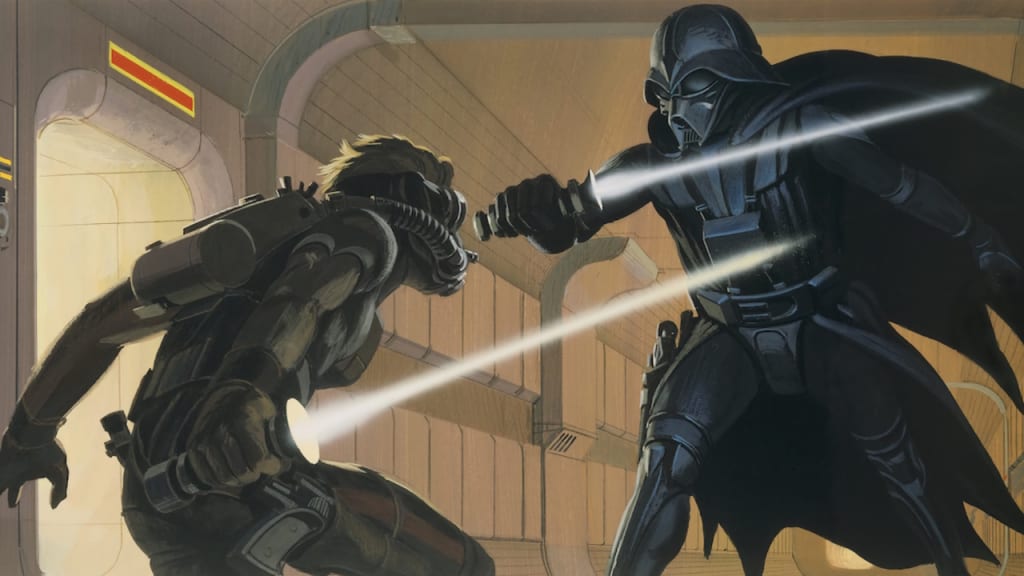Top 7 Characters Based On Original Ralph McQuarrie Concept Art
Check These Out!

Ralph McQuarrie’s influence on the look of the original trilogy can’t be overestimated. Born in 1929, he started to work for Boing in the early '50s, then studied advertising design between 1954 und 1956 and returned to the airplane manufacturing in the early '60s. In 1968, he began working on the CBS News Apollo coverage, while at the same time starting as a freelance illustrator.
McQuarrie and George Lucas first met in November 1974. The director was trying to raise a budget for his space opera from 20th Century Fox, whose executives had no idea how Lucas’ vison of an intergalactic war should look like. And so he hired McQuarrie to do initially 5 paintings depicting key characters and situations of what would later become the first Star Wars movie.
From the mid '70s to the early '80s McQuarrie did hundreds of sketches and paintings and matte paints primarily for Episodes IV and V. By the time preproduction for Return of the Jedi started, he felt burned out and quit his job for Lucasfilm in the summer of 1981, but not before completing more than 300 sketches and about 18 paintings for Episode VI.
McQuarrie’s contributions to Star Wars include among many other things the look of the X-wings and the Y-wings, the TIE-fighters and the Death Star, dozens of creatures from the cantina on Mos Eisley, critters in the swamps of Dagobah, or even an early and a quite disturbing version of Jabba the Hutt.
Lucas had always told him not to worry if and how the things he had drawn could be produced, but just to paint them how he would like them to be. And so for the team at ILM, it was usually the goalpost of everyone’s work to come as close as possible to what McQuarrie had put on the canvases.
Although all of McQuarrie’s works deserve appreciation, today we are going to take a look at the top 7 characters that are based on Ralph McQuarrie concepts:
7. R2-D2
The very first painting that Ralph did for George Lucas is the famous piece that shows C-3PO and R2-D2 walking away from the crashed escape pod.
Lucas’ inspiration for the golden protocol droid was the robot Maria from Fritz Lang’s movie Metropolis (1927), while he wanted something like the little robot from Silent Running (1972) for his astromech companion. But instead of square, McQuarrie made Artoo round and gave him a domed head and three legs, so that he could walk like a person on crutches.

6. Chewbacca
While McQuarrie did his sketches and painting for Lucas, the latter was still working on the script and making some big changes with every iteration. Chewbacca had always been a big guy, but in early versions of the script, he was no “walking carpet,” but a more of an ape-like creature. This concept was many years later reused in Star Wars Rebels for the Lasat Zeb Orrelios.
Later sketches from the fall of 1975 already showed a Chewbacca that looks more like the one we know from the movies.
In the fall of 1977, McQuarrie even draw a young Chewbacca for an early draft of The Empire Strikes Back.

5. Tusken Raiders
Coming from the industrial design work he did for Boing, McQuarrie seldom drew something just because it looked good. Every piece of machinery had to have a purpose. This attitude also came through when he created the Tusken Raiders. He envisioned them with goggles, because he believed them to have some sort of vision problems caused by mutation. The mouthpiece ought to protect them from sandstorms and the little tank underneath was part of a life support system, filled with gas or a chemical.
Unlike many other characters and creatures, the Sand People didn’t change very much from their first concept to the finished film.

4. Darth Vader
Although Darth Vader was not originally intended to be a cyborg, but rather a normal human character, Lucas always envisioned him as a tall and dark figure, who would wear a big hat, like that of a fisher, but made of metal. The mask and the black suit were added, because he and the stormtroopers were originally intended to leap through space from the big Imperial ship to the small Rebel ship at the beginning of the movie.
Apart from the famous painting that shows the duel between Darth Vader and Deak Starkiller, the cover of the novelization of Episode IV also shows McQuarrie’s original Dark Lord.

3. Luke Skywalker
The main hero of the original trilogy did change quite a bit during the early stages of the development of Star Wars: from Deak Starkiller, to Luke Starkiller, to Luke Skywalker. For a time, he was a blond girl with short hair, before becoming a bulkier man who looked like his uncle in Episode II, and also bore a strange resemblance to McQuarrie’s Leia as she was conceived during that time, i.e., the first half of 1975.

2. Yoda
Sometimes the creation of the look of a certain character was a collaboration between more than one person: one artist would sketch something out and another one would use this as an inspiration and build upon and refine it. One such an example is the figure of Yoda, who was originally called Minch and sketched by Joe Johnston as a kind of a garden gnome. McQuarrie used this idea and refined it into something that looked more like the Jedi Master we see in The Empire Strikes Back.

1. Boba Fett
The famous bounty hunter is another example of a combined effort of Johnston and McQuarrie. Originally intended as a super trooper, McQuarrie came up with several helmet concepts, before Johnston developed the look of Boba Fett’s armor that was used in the film. McQuarrie in turn used Johnston’s sketches for his own drawings of the bounty hunter.
One of the helmet concepts was later used in season 3 of The Clone Wars for the bounty hunter Rako Hardeen.

After leaving Star Wars, McQuarrie worked for several other big movies, like E.T., Star Trek IV: The Voyage Home, and Cocoon, but turned down Rick McCallum’s offer to return to the franchise as a designer for the prequel trilogy, as he felt that he had lost his momentum.
He died on March 3, 2012.
Written By Gerald Petschk
Source(s): J. W. Rinzler: The Making of Star Wars, The Making of The Empire Strikes Back, The Making of Return of The Jedi; Carol Titelman: The Art of Star Wars; Deborah Call: The Art of The Empire Strikes Back
Syndicated From Culture Slate






Comments
There are no comments for this story
Be the first to respond and start the conversation.